Sep 3, 2019 | ANA, coin design, coins, commentary, education, technology, US Mint
Although it has been a while since I have posted something outside of the Weekly World Numismatic News, it does not mean that I have been idle. Here are some random thoughts:
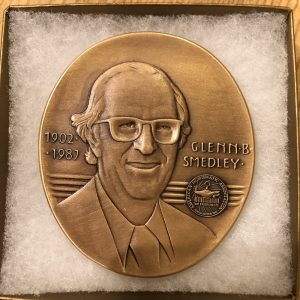
2019 Glenn B Smedley Medal
ANA President Steve Ellsworth asked me to continue as Chair of the Technology Committee. I accepted his appointment. Steve has a different vision for how to move forward. Change is a good thing and will work with him and the Board to do what is best for the ANA.
There continues to be work to do for the ANA to add technology to the numismatic experience. One of the areas I would like to include more technology are the exhibits. After speaking with one person familiar with the exhibiting process, I think there are ways to add technology without technology overshadowing the numismatic content. I will have a proposal shortly. Stay tuned.

2007 Somalia Motorcycle Coins
I love these coins but is this the direction the U.S. Mint should go?
There are many collectibles whose values have declined over the last year, including some collector coins. One area that remains low are those collector sets produced by the television hucksters or the private mints. These firms overhype the value of their wares to convince buyers that they should purchase them as an investment. Recently, I handled an estate with several items purchased from QVC and the Franklin Mint. All of the coins were overpriced. The family was upset when I provided my valuation. I will talk about this more in a future post.
Another article idea that is inspired by my business is the difference between collecting and investing. Although some people like to try to mix the two, most of the time, the result is that the investor does not create a compelling collection while most of the collectors create value without trying.

I sold my silver Pandas. I lost interest after the composition was changed but the hype has kept the prices up. Hype is not a long-term strategy.
Finally, I am still waiting to find a “W” quarter in change. I have yet to see one. Most of the people I know that are looking for these quarters are roll hunting. If I were into conspiracies, I would suggest that the Mint did this on purpose to increase the demand for quarters. People would demand rolls of quarters, forcing the Federal Reserve to order more.
Considering the U.S. Mint is a government agency, I bet they are storing most of the quarters in Area 51! After all, if we are going into conspiracy theories, we might as well go all of the way!
Jul 7, 2019 | coin design, coins, news, US Mint

Newly named Artistic Infusion Program artist Steven Kenny (photo courtesy of www.stevenkenny.com)
Kenny’s primary work is surrealism, a style described as “irrational juxtaposition of images.” There are many different styles of surrealism that many artists have explored. One of the most famous surrealist artists was Salvador Dali.

“The Beach” by Steven Kenny. Available as a print on his website.
The way Kenny approaches a subject makes his selection to the AIP a fascinating choice. The U.S. Mint has always had a problem figuring out how to create designs for complex subjects. It is one thing to design a coin with an organization’s logo or the bust of a person, but what about design a coin for a national park, a forest, or an event?
Although seeing a surrealistic design on a coin would be interesting, someone with a background in surrealism has a different view that has the potential to improve on coin designs.
Kenny’s selection to the AIP is a very interesting move for the U.S. Mint. Whoever made the selection should be praised for not only selecting a talented artist but one with a different perspective.
I encourage everyone to explore Steven Kenny’s website to see more about his art.
And now the news…

June 30, 2019
Using powerful infrared light, researchers have found a way to tint metal without dyes or pigments – with scientific implications far beyond coin-collecting  → Read more at theglobeandmail.com
→ Read more at theglobeandmail.com

July 2, 2019
The U.S. Mint selected St. Petersburg surrealist painter Steven Kenny to create designs for coins.  → Read more at abcactionnews.com
→ Read more at abcactionnews.com

July 3, 2019
PHOTO: “MIR”  → Read more at galpost.com
→ Read more at galpost.com

July 3, 2019
To continue, please click the box below to let us know you're not a robot.  → Read more at bloomberg.com
→ Read more at bloomberg.com

July 3, 2019
 → Read more at kitco.com
→ Read more at kitco.com

July 4, 2019
A rare gold solidus dating back 1,600 years has been found by a group of Israeli students in the Galilee region.  → Read more at sci-news.com
→ Read more at sci-news.com

July 4, 2019
A treasure trove of Arab coins dating back some 1,000 years has been discovered in an old German cemetery near the Baltic coast.  → Read more at thefirstnews.com
→ Read more at thefirstnews.com
Dec 20, 2018 | coin design, coins, dollar, US Mint
 Since U.S. Mint announced the launch of the American Innovation $1 Coin Program there has been nothing but complaints from the community about the coin.
Since U.S. Mint announced the launch of the American Innovation $1 Coin Program there has been nothing but complaints from the community about the coin.
According to the law (Public Law No: 115-97), “The common design on the obverse of each coin issued under this subsection shall contain a likeness of the Statue of Liberty extending to the rim of the coin and large enough to provide a dramatic representation of Liberty.” With the U.S. Mint under a short deadline because of when the bill became law (July 20, 2018), there were a number of disagreements with the Citizens Coinage Advisory Committee regarding the obverse design of the coin. The U.S. Mint tried to modify an old design but the CCAC did not like that. Eventually, the design from Miss Liberty’s left side was used.
It has turned out to be an elegant design that does not duplicate any previous one. She stands on the coin as stately as she stands in New York Harbor, extending from rim to rim as required by law. For once, the CCAC and I agree on a good design.
But that is not enough for some people. The design is too plain.
The reason why the coin appears plain is that two elements that could have been on the obverse, the date and motto “E Pluribus Unum,” are on the edge of the coin.
Edge lettering for the $1 coins began in 2007 with the introduction of the Presidential $1 Program. It was decided to move these elements, along with “In God We Trust” to the edge because the obverse was to include the years of the president’s term. Aside from providing more space for the design, relocating the date would prevent potential confusion as to the date of the coin.
“In God We Trust” was restored to the obverse of the coin in 2009 after striking errors caused the edge of the coin to be blank. This caused overzealous conspiracy theorists and the gullible believing that this was done purposely against the religious communities.
Some argue that since the conditions have changed, the coin should not have edge lettering.
Aesthetically, the obverse design was well executed. It would be how the statue would look if you were standing in Battery Park located at the southern tip of Manhattan, and looked across the water on a clear day. There should be no reason to change the design.
However, there is a problem with the edge lettering in that it makes it difficult to see. As someone who has reached the age where an annual eye exam is a requirement and “corrective lenses” is now a permanent fixture on my driver’s license, having the mintmark on the edge requires me to use magnification to find the mintmark.
As a member of the Baby Boomer generation whose glasses seem to get stronger every year, I would be in favor of moving the date and mintmark to the obverse of the coin. But if the problem is only aesthetics, then I have no problems with having to use a 16x loupe to help identify where the coin was struck.
Oct 23, 2018 | CCAC, CFA, coin design, commemorative, commentary
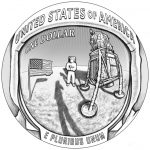
Reverse of the Apollo 11 50th Anniversary Commemorative Coin
It looks like these two groups that are supposed to be the gatekeepers of the design of U.S. coinage did not fully think through their design selection for the Apollo 11 Commemorative Coin program.
When the line art images were sent out, the design did not immediately remind me of a bootprint on the surface of the moon. Actually, it reminded me of something that many of us have placed our bootprint on a little closer to the ground.
-
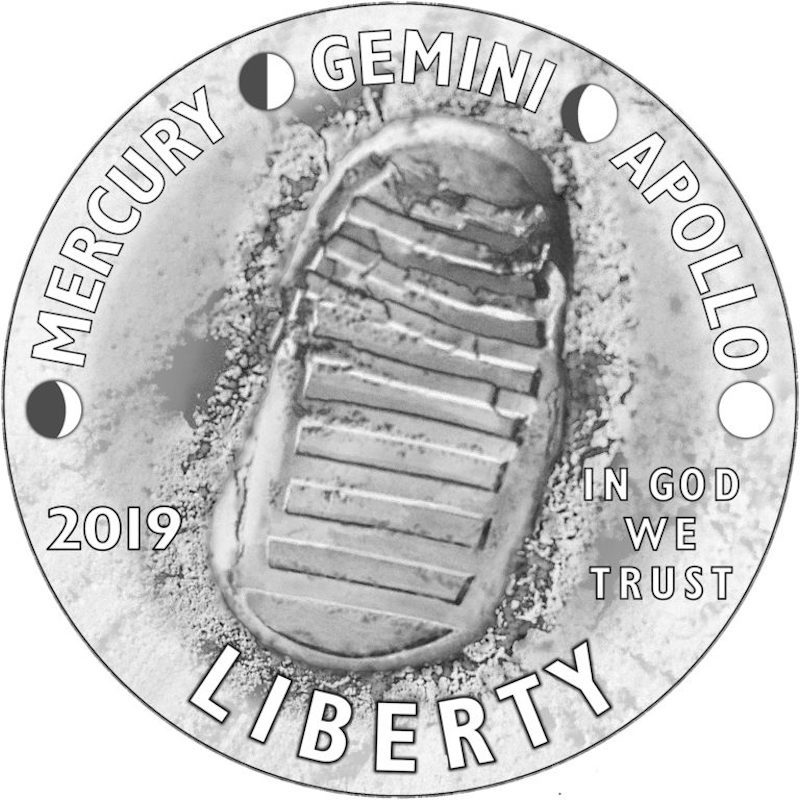
-
Obverse design of the Apollo 11 50th Anniversary Commemorative Coin program
-
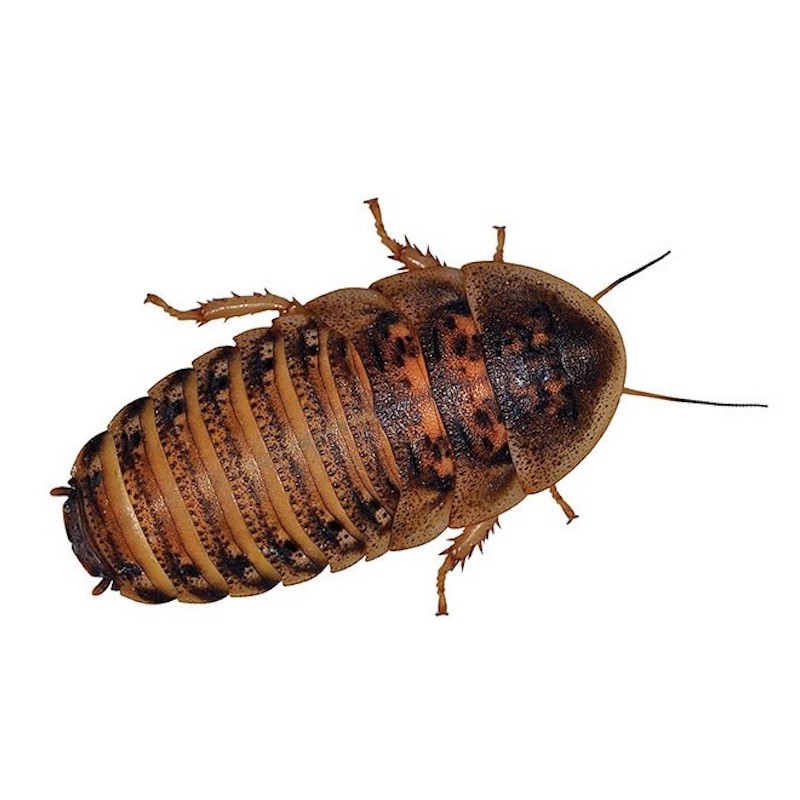
-
A Dubia Roach (Blaptica dubia)
I understand that with the resignation of Kareem Abdul-Jabbar from the CCAC that this august body may be lacking the appropriate point of reference that Abdul-Jabbar and I have to make the tie between the bootprint and an insect that could probably survive on the moon (he was born Lew Alcindor in New York City). Then again, the CCAC is the same organization, albeit, with different members, that gave us some of the worst designs in modern coinage.
For the 50th anniversary of one of the greatest achievements of the 20th century, all the CCAC could come up with is a bootprint?
Aug 28, 2018 | coin design, commentary, US Mint
On Monday, the U.S. Mint announced that on September 3, they will begin accepting applications for the Artistic Infusion Program. Judging by the last round of artwork submitted to the Citizens Coinage Advisory Committee to review for the new American Innovation $1 Coin, they need the help.
For those who did not read the stories, the U.S. Mint submitted a design for the obverse that is supposed to be “a likeness of the Statue of Liberty extending to the rim of the coin and large enough to provide a dramatic representation of Liberty,” similar to the reverse of the Presidential $1 coins. According to reports, the U.S. Mint claimed that they could not work on a better design because of time constraints.
Time constraints are a legitimate issue. The bill was signed into law on July 20, 2018, leaving the U.S. Mint less than six months until the program begins in 2019. However, that does not mean that the program has to begin on January 2. In fact, the law does not specify at what point during the year that the coins are to be produced.
They also could have anticipated their responsibility. Once the bill was passed by the Senate on June 20, it was only a matter of time that the difference between the House and Senate versions were resolved before being signed by the president. It was not a surprise. They had two months to come up with something prior to the CCAC meeting.
Although U.S. Mint Director David Ryder has not been on the job long, he has to take responsibility for not providing the leadership necessary to impress on the artists and whoever directed them not to try to take the easy way out. If they have not learned by now, most of the CCAC members take their jobs much more seriously than previous committees (this is a good thing) and are very outspoken in a very constructive manner.
One person that should respond to this call for artists is current CCAC member Heidi Wastweet. An accomplished medalist and sculptor, her term with the CCAC is about to expire. She is well qualified since her work is phenomenal! You can see for yourself on her website. Imagine what an artist with her talent and knowing what the CCAC is looking for can add to the U.S. Mint.
Having never met Ms. Wastweet, I am not in a position to try to talk her into applying. However, if you are acquainted with her, please let her know that not only would it be of great service to the U.S. Mint but that she has at least one endorsement—for whatever that is worth!
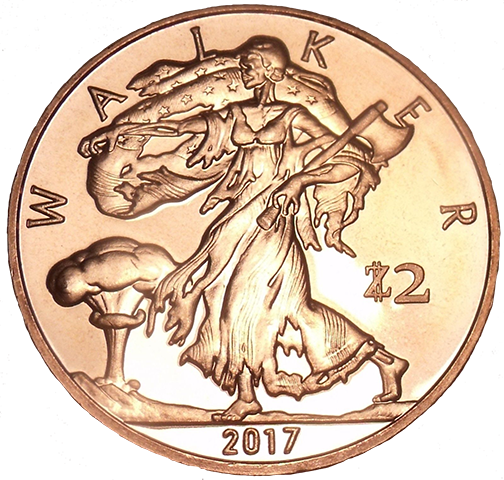
There are so many great medals on Heidi Wastweet’s site it is difficult to select one to highlight. But I always seem to focus on this one called a Zombuck.
Aug 4, 2018 | Carson City, coin design, coins, commemorative, commentary, legislative
NOTE: The title is NOT a typographical error. It is a commentary raised by the discussion, below.
With the flurry of legislative action last month, the only bill that I commented on was the American Innovation $1 Coin Act (Public Law No: 115-197) because it was the only one that is the law. The others were just introduced and may not be passed out of committee.
But that has not prevented speculation and discussion about the potential for these potential commemorative coins. Based on the email buzz, the two bills of interest are the Integration of Baseball Commemorative Coin Act (S. 3283 and H.R. 6469) and the Carson City Mint 150th Anniversary Commemorative Coin Act (H.R. 6221).
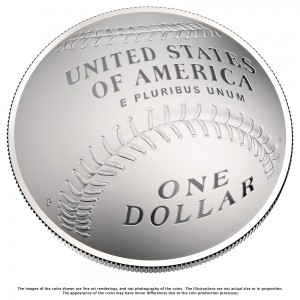
Reverse design of the 2014 Baseball Hall of Fame commemorative (Image courtesy of the U.S. Mint)
For those commentators who cannot read simple English, it says that the design “shall depict a baseball diamond.” Nowhere in that sentence does it say that the coins have to be shaped like the baseball diamond. A depiction and the shape of a coin are two different concepts.
Trying to understand where the idea that the coins would be square, a review of the official statement issued by Sens. Tim Scott (R-SC), Cory Booker (D-NJ), and Rep. Roger Williams (R-TX) as co-sponsors does not mention the shape of the coin.
What might have confused the issue was a report in The Hill that former Montreal Expos and Chicago Cubs legend Andre “The Hawk” Dawson talked about the coin minted in the shape of home plate. While Dawson was a great ballplayer and earned his place in the Baseball Hall of Fame, he is not a member of Congress and, apparently, did not read the bill.
The commentary about the shape does not take into consideration what the bill actually says. Aside from talking about it like it will be the law, it does not take into consideration that the bill is now in committee with less than 90-days to go until the mid-term elections. Without turning this into a political analysis blog post, there will be contention regardless of the outcome of the election. With the late introduction of this bill and the current political environment, the likelihood of this bill passing both chambers before the end of the session is highly unlikely.

Carson City Mint (1866)
Even though the first press used in Carson City is located in the museum, it may not meet the specifications that are required of the U.S. Mint to strike modern commemorative coins. And both the press and building are not owned by the United State government, a fact that would make those who provide oversight of the U.S. Mint’s operations a bit nervous.
While these “what if” questions might make good parlour or message board discussions, allegedly responsible industry journalists and pundits should know better.
Jun 1, 2018 | coin design, coins, gold, legislative
Although it is not really a numismatic-related bill, the Saint-Gaudens National Historical Park Redesignation Act appears to be on track for passage in the Senate.
Essentially, the bill redesignates the Saint-Gaudens National Historic Site, Augustus Saint-Gaudens’ former home in New Hampshire, as the “Saint-Gaudens National Historical Park.” The change is significant in that it changes the funding for the staffing and maintenance of the site. It also will keep the site accessible for tourism.
Augustus Saint-Gaudens is known as the artist who co-conspired with President Theodore Roosevelt in his “pet crime” to redesign United States coinage. Before his death in 1907, Saint-Gaudens provided the design for the $20 Double Eagle and $10 Eagle gold coinage.
Saint-Gaudens’ legacy did continue after his death by his students Adolph A. Weinman, designer of the Walking Liberty half-dollar and Mercury dime, and James Earle Fraser, designer of the Buffalo Nickel.
S. 2863: National Law Enforcement Museum Commemorative Coin Act
Read twice and referred to the Committee on Banking, Housing, and Urban Affairs. — May 16, 2018
H.R. 965: Saint-Gaudens National Historical Park Redesignation Act
Summary: (Sec. 2) This bill redesignates the Saint-Gaudens National Historic Site, in New Hampshire, as the "Saint-Gaudens National Historical Park."
Referred to the House Committee on Natural Resources. — Feb 7, 2017
Placed on the Union Calendar, Calendar No. 197. — Aug 25, 2017
Reported (Amended) by the Committee on Natural Resources. H. Rept. 115-277. — Aug 25, 2017
Mr. Thompson (PA) moved to suspend the rules and pass the bill, as amended. — Oct 2, 2017
Considered under suspension of the rules. — Oct 2, 2017
DEBATE – The House proceeded with forty minutes of debate on H.R. 965. — Oct 2, 2017
At the conclusion of debate, the Yeas and Nays were demanded and ordered. Pursuant to the provisions of clause 8, rule XX, the Chair announced that further proceedings on the motion would be postponed. — Oct 2, 2017
Considered as unfinished business. — Oct 2, 2017
On motion to suspend the rules and pass the bill, as amended Agreed to by the Yeas and Nays: (2/3 required): 401 – 0 (Roll no. 545). — Oct 2, 2017
Motion to reconsider laid on the table Agreed to without objection. — Oct 2, 2017
Received in the Senate and Read twice and referred to the Committee on Energy and Natural Resources. — Oct 3, 2017
Committee on Energy and Natural Resources. Ordered to be reported without amendment favorably. — May 17, 2018
Apr 6, 2018 | coin design, coins, commentary
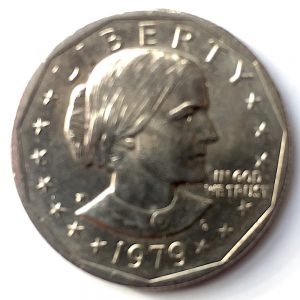
A 1979-D Susan B Anthony dollar found in change that was mistaken for a quarter.
This week, I was involved in a real-life example of this confusion.
While getting ready to retire for the evening, I empty my pockets on my dresser and look to see if there is anything interesting. Since my only trip of the day was a local grocery store, I did not expect anything. As I looked at what I thought was 78-cents something did not look right. As it turned out, one of the quarters was not a quarter.
Mixed in with the change from my single transaction of the day was a 1979-D Susan B. Anthony dollar coin. Not only did the cashier make the mistake, but when I accepted the change I did not catch the difference.
A real-life example as to the reason why the Susie B. was not a successful coin!
Oct 30, 2017 | coin design, coins, Eagles, platinum, US Mint
Over a week ago, the U.S. Mint announced that they will begin a three-year series of the American Platinum Eagles proof coins featuring designs inspired by the Declaration of Independence. After looking at the designs and the designs of past platinum proof coins, they may be one of the most under-appreciated series of coins produced by the U.S. Mint.
-
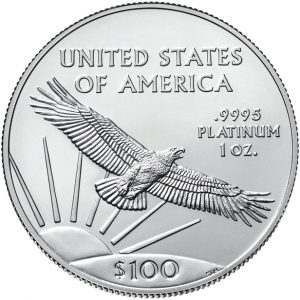
-
American Platinum Eagle bullion reverse design
-
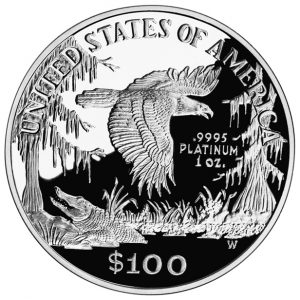
-
1999 American Platinum Eagle Proof reverse – Vistas of Liberty Reverse Designs – Eagle Above Southeastern Wetlands
-
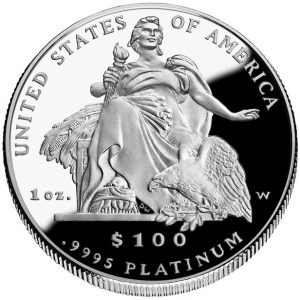
-
2004 American Platinum Eagle proof reverse – Daniel Chester French’s “America” that sits before the U.S. Customs House in New York City.
Since its introduction in 1997, the U.S. Mint has produced four series of proof coins with the reverse honoring different aspects of the nation. To see the list, see the “U.S. Coins by Type” page.
What distinguishes these coins are the well-executed reverse designs that few get to see or pay attention. It may be difficult for the average collector to consider collecting these coins because of the price of platinum has been either on par or higher than the price of gold. Also, platinum is not as well regarded as gold or silver as a precious metal causing it to be overlooked.
-

-
2006 American Platinum Eagle proof reverse – Branches of Government Series – “Legislative Muse” representing Legislative Branch
-
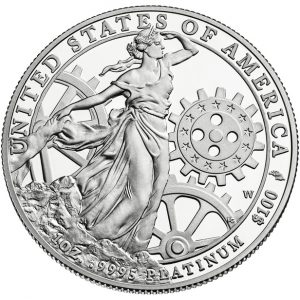
-
2013 American Platinum Eagle proof reverse – Preamble Series – “To Promote the General Welfare”
-

-
2016 American Platinum Eagle proof reverse – Nations Core Values – “Liberty and Freedom”
Since many of these coins did not sell in large quantities, many could be classified as modern rarities. But do not let the lack of supply dissuade you. Prices could be in the range of their bullion value plus a modest numismatic premium because the demand is also lower.
It is too bad these designs are confined to platinum coins. Unfortunately, the authorizing laws allow the U.S. Mint to do this with the platinum coins but not with silver. Since silver is more affordable for the average collector, maybe it is worth trying to ask Congress to change the law to allow these types of series for the American Silver Eagle proof coins.
Coin images courtesy of the U.S. Mint.
Oct 23, 2017 | coin design, coins, commemorative
Design of the 2018 Breast Cancer Awareness Commemorative Gold Coin was announced today on Fox 5 New York featuring interviews with New York Rep. Carolyn Maloney (D), the sponsor of the authorizing legislation (Public Law 114-148) and Myra Biblowit, President of the Breast Cancer Research Foundation, the organization that will receive whatever is collected from the surcharges.
No additional details were provided including the name of the winning designer or whether the silver dollar and clad half-dollar will have the same design.
Here is the video segment from “Good Day New York:”
Still frame of the reverse design also from “Good Day New York:”
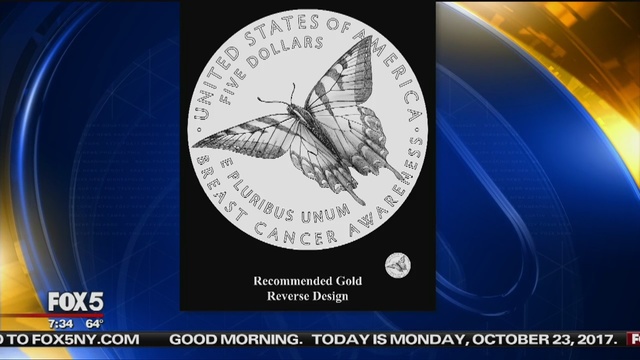
Still frame of Breast Cancer Awareness commemorative coin reverse from Fox 5 NY
Summary of the Breast Cancer Awareness Commemorative Coin Program
- Commemorative coins issued in 2018
- Design, emblematic of the fight against breast cancer, selected from a juried competition with no less than $5,000 going to winning design
- “The Secretary shall encourage three-dimensional designs to be submitted as part of the proposals”
- 50,000 $5 “pink gold” coins with an alloy of at least 75-percent gold with a $35 surcharge
- 400,000 one-ounce silver dollars made with not less than 90-percent silver with a $10 surcharge
- 750,000 clad half-dollar coins with a $5 surcharge
- Surcharges will be distributed to the Breast Cancer Research Foundation of New York, to further breast cancer research funded by the Foundation.
Pink gold can be more commonly described as “rose gold.” Rose gold is an alloy of 75-percent gold with 20-percent copper and 5-percent silver. The color can be adjusted by changing the ratio of copper and silver.





 → Read more at
→ Read more at 















